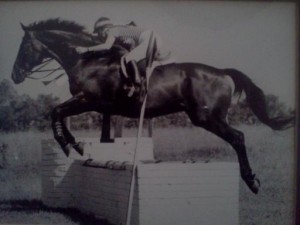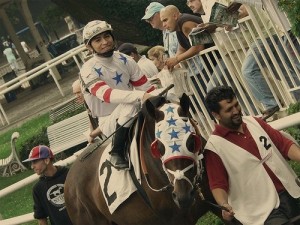Author’s note: This story was originally published on April 20, 2012.
Walking “hots” for Hall of Fame trainer Elliott Burch back in the 70s, Ann Banks learned the right way to treat racehorses.
Nobody yelled at them; they weren’t shanked around; and never did the blare of loud music disrupt the sanctity of the stabling area.
“It was peaceful and quiet,” she recalls. “I learned to be respectful, and to speak softly to the superstar racehorses.”
Stars she knew personally, by their quirks and charms, included Horse of the Year Arts and Letters and Key to the Mint, Eclipse Award American Champion Three-Year-Old Male.
On her summers off from the University of Kentucky, where she earned degrees in horse husbandry and agricultural communications, Banks learned from the Rokeby Stables crew at Belmont Park that horses, who worked so hard for their owners, deserved to be treated well.
After she graduated, and soon after embarking on an intense career of breeding and training racehorses, Banks says she found her “mission.”
“For the next 24 years, I dove into all the racetrack stuff. And once I got onto the backside, I understood very quickly that there are different degrees of failure for horses, of not being able to do their job,” she says. “This is where it became obvious to me that if a horse couldn’t win to pay his expenses, the horse should be stopped from racing while he still has legs, and helped into a new home.”
Growing up an avid equestrian, who felt deeply privileged to work those early years for the fabled race farm, it was ingrained in her that an ex-racehorse could do many other jobs if the one at the track didn’t pan out.
“There was never an ah-ha moment,” Banks says. “It was always understood that if a horse couldn’t do this, that maybe he could be a fox hunter, or a jumper or an eventer.
“It never occurred to me that a racehorse couldn’t do something other than race.”
Her first off-track Thoroughbred English Jack, for example, became her favorite personal eventing horse after 115 starts in nine years.
“By the time I met Jack, he had been through the wars at cheap tracks at the end of his career, but he never bore a grudge,” Banks says. “His red badge of courage was a bigger than normal cannon bone on one leg, where he must have fractured it. But, the amazing thing about Jack, and about Thoroughbreds I’ve met, is that they’ve never held a grudge, no matter what circumstances they survived.”
The endurance of her own “big class horse,” who possessed the “look of eagles in his eye,” and memories of the racing greats she hot-walked as a young lady, stuck with her through myriad experiences in the horse world.
“I always felt a huge responsibility to be a good steward of the horses in my care because they have given me such joy,” she says. “I strive to help Thoroughbreds be good ambassadors of the breed—I learned early that Thoroughbreds were given a bad rap as a difficult breed— and to prove to the sporthorse community that there are responsible Thoroughbred people who take care of their horses.”
She did this in spades while working for her husband David Banks, and his racing stable, with such successful results: She estimates that over 100 ex-racehorses moved on to new careers from her farm.
By working methodically, Banks studies a new horse in her care, watching the retired racehorse move around the backyard of her house. Her keen observations inform her of the horse’s soundness, personality, and potential talent for a new job.
“The horses that are big movers and carry themselves up and round are great candidates to go eventing,” she explains. “And the ones who carry themselves long tend to make the best hunters.”
When Dancing Dynamo, a son of Three Chimneys pensioned stallion and former studDynaformer, arrived at her farm, there wasn’t much that characterized him, good or bad.
“In fact, he was laid back,” she says, adding, “Dynamo did not distinguish himself at the races … and he was here for a long time.”
While he grazed in a herd of retirees, she let his feet grow out, and his body fill in.
And when she decided he might make a children’s hunter prospect, she shipped him to Winner’s Circle Farm outside Nashville, where longtime partner in training, Dwight Hall, has developed some beautifully retrained racehorses.
“Dynamo came around very quickly,” she says. “Dwight takes a lot of time to evaluate a horse, too. But, it didn’t take him long to figure out that Dynamo would make a great children’s horse.”
Banks and Hall weren’t wrong. He was sold to one of Hall’s young riding students, and in no time, the pair was winning championships throughout the Tennessee region.
Among his honors, Dynamo was the 2011 Middle Tennessee Hunter/Jumper Association Reserve Champion in two divisions, pre-children’s hunter and modified junior hunter, and was the 2010 Middle Tennessee Hunter/Jumper Association Reserve Champion in modified junior hunter.
What delights Banks about Dynamo’s new career is watching the obvious affection between horse and rider, and the great precision with which the once lackluster racehorse tackles a jumps course.
He proves, as did her long-time mount English Jack, and so many horses in between, that Thoroughbreds are brilliantly sensitive creatures willing to give 110 percent toward their job, she says.
“On Long Island, where I grew up, Thoroughbreds were the breed of choice,” Banks says. “I learned early on that they deserved to be treated with respect, and that it was important to be a good steward for the horse.”
Ann Banks is on the board of the Kentucky HBPA, and was one of the first riding instructors at Kentucky’s Masterston Station Park. She also served as a stadium-jumping steward at Rolex for 10 years.






It is great to see another person that has a great love and respect for the OTTB. Ride and love a OTTB!